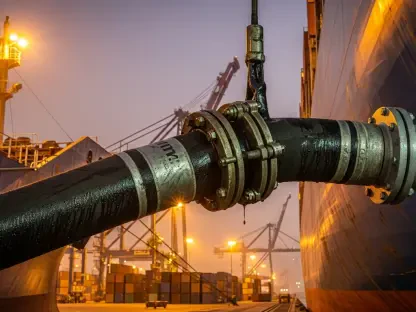Introduction to the Export Surge
Imagine a summer where European skies are buzzing with unprecedented air travel, yet the continent struggles with dwindling jet fuel supplies, while across the globe, Asian refineries grapple with an excess of the same resource. This stark contrast has fueled a remarkable surge in jet fuel exports from Asia to Europe in July, reaching levels not seen in several years. The phenomenon raises critical questions about the economic forces and logistical dynamics driving this trend, as well as how regional supply-demand imbalances are shaping global energy trade patterns.
This unexpected spike in exports highlights a pivotal moment in the aviation fuel market, where price disparities and strategic shipping decisions converge to address urgent needs. Understanding the reasons behind this surge offers valuable insights into the interconnected nature of energy markets and the factors influencing fuel availability during peak travel seasons. It also sets the stage for a deeper exploration of how such trends impact both regional economies and international trade flows.
Background and Importance of the Trend
The jet fuel market is a vital component of the global energy sector, with Asia serving as a major production hub through key exporters like South Korea, China, and various Southeast Asian nations. These countries have built significant refining capacities, often producing more fuel than their domestic markets can absorb, leading to a consistent need to find international buyers. Europe, on the other hand, is a critical consumer market, especially during summer months when air travel peaks, straining local supply chains.
This surge in exports from Asia to Europe carries substantial implications for regional supply dynamics, as it temporarily alleviates oversupply pressures in Asian markets while addressing shortages in European hubs. The trend is particularly significant given the timing, aligning with heightened summer demand for air travel, a period when fuel availability can directly influence airline operations and ticket pricing. Beyond regional impacts, this movement underscores the interconnectedness of global energy markets, where localized imbalances can trigger widespread trade shifts.
Moreover, the export boom reflects broader themes in energy trade, including the responsiveness of markets to price signals and the role of logistical infrastructure in facilitating rapid adjustments. As such, it provides a case study in how global supply chains adapt to seasonal and economic pressures, offering lessons for policymakers and industry stakeholders navigating similar challenges in other sectors.
Market Dynamics and Key Drivers
Supply and Demand Imbalances
A fundamental driver of the export surge lies in the contrasting supply and demand conditions between Asia and Europe. In Asia, refineries have faced an oversupply of jet fuel, with production outpacing local consumption, leading to stockpiles that need to be offloaded. Conversely, Europe has experienced tight supply conditions, with stockpiles in the Amsterdam-Rotterdam-Antwerp (ARA) hub dropping to 745,000 tons in July, the lowest since February and below the yearly average of 846,000 tons, signaling an urgent need for imports.
European demand has further compounded this imbalance, fueled by a robust recovery in air travel. Data from Eurocontrol indicates a 4% year-on-year increase in daily flights for July, alongside a 3% rise compared to pre-pandemic levels in 2019. This heightened activity, particularly during the peak summer travel season, has placed significant pressure on fuel reserves, making imports from Asia a critical solution to meet immediate needs.
Economic Incentives: Arbitrage Opportunities
Economic factors have played a central role in motivating Asian exporters to target European markets. Physical jet fuel prices in Northwest Europe during July averaged $65 per ton higher than in Asia, an increase from a $50 per ton differential in June, according to LSEG data. This substantial price gap has created a lucrative arbitrage opportunity, where exporters can achieve higher profits by shipping fuel to Europe rather than selling it locally or to other regions.
This financial incentive is a direct response to market signals, where strong seasonal demand in Europe contrasts with weaker consumption trends in Asia. The profitability of these exports has encouraged major players, particularly from South Korea and China, to redirect shipments toward Western markets, capitalizing on the temporary but significant disparity in pricing structures.
Logistical Advantages
Beyond economic motivations, logistical improvements have facilitated the export surge. Shipping costs for jet fuel on LR2 tankers decreased notably in July, averaging $3.75 million for a 90,000-ton shipment compared to $4.4 million in June, as reported by shipbroker SSY. This reduction, partly attributed to geopolitical de-escalation in certain conflict zones, has lowered the overall expense of long-distance fuel transport.
Reduced shipping costs have directly supported higher export volumes by making it more feasible for Asian suppliers to send larger quantities to Europe. This logistical ease, combined with the urgent demand in European markets, has created an ideal environment for ramping up trade flows, ensuring that fuel reaches critical hubs in a timely and cost-effective manner.
Research Insights and Data Analysis
Methodology
To understand the dynamics of this export surge, a comprehensive analysis was conducted using multiple data sources and analytical approaches. Shiptracking data from Vortexa provided detailed insights into export volumes and shipping routes, while market data from LSEG and SSY offered critical information on price differentials and shipping costs. Additionally, industry insights from trade sources enriched the understanding of regional market conditions and exporter strategies.
The scope of the analysis encompassed a detailed examination of export trends, focusing on volumes shipped from Asia to Europe, alongside an assessment of economic and logistical factors influencing these movements. By integrating quantitative data with qualitative perspectives, the research aimed to present a holistic view of the factors driving this significant market shift.
Findings
The analysis revealed a sharp increase in Asian jet fuel exports to Europe, with volumes ranging between 600,000 and 775,000 metric tons in July, up from approximately 500,000 tons in June. According to Vortexa, this represents a three-year high, while trade sources suggest it may be the highest level in five years, underscoring the exceptional nature of the surge. Key contributors included China and South Korea, with China alone projecting exports exceeding 2.3 million tons for both July and August due to increased output and favorable margins.
Further insights highlighted the role of specific market conditions in sustaining this trend. For instance, China’s leading refiner, Sinopec, has ramped up production amid plateauing domestic flight demand, as noted by consultancy FGE. Trade sources also emphasized that jet fuel remains the most profitable product for Chinese refiners compared to other fuels, reinforcing the focus on exports to Europe.
Implications
The export surge has notable implications for both Asian and European markets. In Asia, redirecting excess fuel to Europe helps mitigate oversupply, potentially stabilizing regional prices that have been under pressure due to weak local demand. This outflow provides a temporary relief valve for refineries facing inventory challenges, allowing for better capacity management.
In Europe, the influx of jet fuel addresses critical supply shortages, supporting the heightened demand driven by summer travel. However, the sustainability of this trend remains uncertain, as narrowing arbitrage margins could reduce the economic incentive for continued high export levels in the coming months. This dynamic suggests a need for close monitoring of price trends and market adjustments.
Reflection and Future Outlook
Reflection
Analyzing the complexities of global jet fuel trade reveals the intricate interplay of economic, logistical, and geopolitical factors that shape market movements. Predicting shifts in this landscape poses challenges due to the volatility of price differentials and the unpredictability of international events that can impact supply chains. Such uncertainties highlight the difficulty in forecasting long-term trends with precision.
Moreover, limitations in data granularity often hinder a fully detailed understanding of short-term market fluctuations. Real-time insights are essential to capture transient opportunities and risks, yet accessing such data remains a constraint for comprehensive analysis. These challenges underscore the need for adaptive research approaches to keep pace with rapidly evolving trade patterns.
Future Directions
Looking ahead, further research should explore the long-term sustainability of elevated export levels from Asia to Europe, particularly as seasonal demand in Europe may wane post-summer. Investigating how changing geopolitical or economic conditions could influence trade flows offers another critical avenue for study, providing a deeper understanding of potential disruptions or opportunities.
Additionally, examining shifts in European demand patterns and their impact on arbitrage opportunities for Asian exporters could yield valuable insights. Such analysis would help anticipate whether current export trends represent a structural shift in global jet fuel trade or a temporary response to specific market conditions, guiding strategic planning for industry stakeholders.
Conclusion: Understanding the July Surge
The dramatic rise in Asian jet fuel exports to Europe during July emerged from a confluence of compelling price differentials, lowered shipping costs, and stark regional supply-demand disparities. This market response not only alleviated pressures in Asia but also bolstered fuel availability in Europe during a critical travel period. The contributions of major exporters like China and South Korea stood out as pivotal in driving this unprecedented volume.
Moving forward, stakeholders should prioritize monitoring evolving arbitrage margins and seasonal demand shifts to anticipate potential slowdowns. Developing flexible supply chain strategies will be essential to adapt to fluctuating market conditions. Additionally, investing in real-time data systems could enhance the ability to respond swiftly to emerging trends, ensuring that both exporters and importers remain agile in a dynamic global energy landscape.









